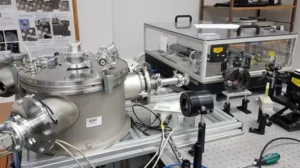The launch of the EU co-funded project Lasers4EU on October 1, 2024, marks a new era in laser research. By bringing together 29 leading laser research institutions across Europe, the project offers a central platform with unprecedented access to cutting-edge laser technologies and services for external scientists from academia and industry.
The Institute of Optoelectronics of the Military University of Technology (WAT), the only partner from Poland, will share its equipment, developed by the Laser-Matter Interaction Team, through the Lasers4EU project. The project commenced on October 1, 2024.
According to Prof. Henryk Fiedorowicz, head of the Institute of Optoelectroics , the unique equipment will be useful in various fields, including materials science, nanotechnology, biomedical engineering, laboratory astrophysics, and biomedicine. Its operation is based on laser-plasma sources of X-ray and extreme ultraviolet (EUV) radiation, using a pulsed gas target, technologies also developed within the same research team.
Prof. Fiedorowicz explains that the Lasers4EU project serves as a platform that allows external users to access European laser research infrastructure.
A key aspect of the project is the comprehensive training offered alongside the equipment. Participants will enrich their theoretical and practical knowledge with specialized information on laser technologies and their applications.
The project aims to expand the geographical reach of European research infrastructure, support new initiatives in this field, and promote collaboration between laser research centers. Another key goal is to increase the number of specialists in Europe in the area of lasers and their applications. Comprehensive training will equip the next generation of scientists with the skills and knowledge needed to fully utilize leading European laser infrastructures.
The project have received 5 million euros from the European Union.
For detailed information about the Lasers4EU project, including the available research infrastructure, guidance for future users, and instructions on how to gain access, please visit the project website at lasers4.eu.

Photo: The Institute of Optoelectronics, WAT
Source:


